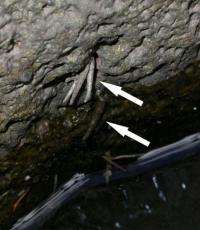Amphibious caterpillars discovered in Hawaii (w/ Video)

Moths of the Hawaiian genus Hyposmocoma are an oddball crowd: One of the species' caterpillars attacks and eats tree snails. Now researchers have described at least a dozen different species that live underwater for several weeks at a time.
"I couldn't believe it," said study co-author Daniel Rubinoff, an evolutionary biologist at the University of Hawaii at Honolulu, of the first time he spotted a submerged caterpillar. "I assumed initially they were terrestrial caterpillars ... how were they holding their breath?"
Each of the 12 species lives in and along streams running down the mountains on several different islands of Hawaii, said Rubinoff, who has studied Hyposmocoma, a group of more than 350 moth species, for more than seven years.
They usually eat algae or lichen, and build silk cases -- which one species even adorns with bird feathers -- for shelter and camouflage. They spin silk drag lines to withstand the high pressure of fast flood waters.
Unlike other amphibious creatures that can survive underwater on stored oxygen but must come back up for air, these caterpillars can spend several weeks without ever breaking the surface, according to the paper, which was published online Monday in Proceedings of the National Academy of Sciences.
It isn't yet clear how the insects do it. Rubinoff and co-worker Patrick Schmitz of the University of Hawaii did not find any water-blocking stopper over the caterpillars' tracheae or evidence of gills. The animals drowned quickly when kept in standing water, so they seem to need the higher levels of oxygen present in running water, and probably absorb it directly through pores in their body, the scientists said.
The trait appears to have evolved more than once, Rubinoff said. After analyzing the DNA of the 12 amphibious species, the scientists found that three separate lineages of moth had developed the ability to breathe underwater at different points in the past.
Why they evolved this trick isn't clear, but animals and plants are known to often evolve in surprising directions after arriving at new, sparsely populated habitats such as islands, said Felix A.H. Sperling, an entomologist with the University of Alberta in Edmonton.
In a new environment, released of the pressure of having to fight for food sources or evade predators, they are freer to expand into new niches.
"When the pressures on an environment are released, what crazy things are animals capable of doing?" said John W. Brown, a research entomologist with the U.S. Department of Agriculture.
"You just wonder ... do all animals have that potential?"
More information: Multiple aquatic invasions by an endemic, terrestrial Hawaiian moth radiation, PNAS, Published online before print March 22, 2010, doi:10.1073/pnas.0912501107
(c) 2010, Los Angeles Times.
Distributed by McClatchy-Tribune Information Services.
















